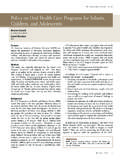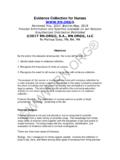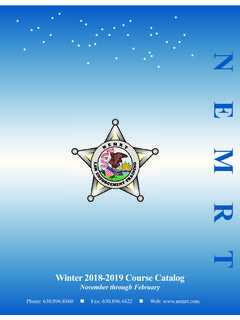Transcription of Guideline on Oral and Dental Aspects of Child Abuse and ...
1 REFERENCE MANUAL V 37 / NO 6 15 / 16. Guideline on oral and Dental Aspects of Child Abuse and Neglect Originating Group American Academy of Pediatrics Committee on Child Abuse and Neglect and the American Academy of Pediatric Dentistry Review Group American Academy of Pediatrics Committee on Child Abuse and Neglect and the American Academy of Pediatric Dentistry Council on Clinical Affairs Adopted 1999. Revised 2005. Reaffirmed 2010. Abstract In one study,12 the lips were the most common site for In all 50 states, physicians and dentists are required to report inflicted oral injuries (54 percent), followed by the oral mu- suspected cases of Abuse and neglect to social service or law cosa, teeth, gingivae, and tongue. Discolored teeth, indicating enforcement agencies.
2 The purpose of this report is to review pulpal necrosis, may result from previous trauma. 13,14 Gags the oral and Dental Aspects of physical and sexual Abuse and applied to the mouth may result in bruises, lichenification, or Dental neglect and the role of physicians and dentists in eva- scarring at the corners of the luating such conditions. This report addresses the evaluation of Some serious injuries of the oral cavity, including posterior bite marks as well as perioral and intraoral injuries, infections, pharyngeal injuries and retropharyngeal abscesses, may be in- and diseases that may be suspicious for Child Abuse or neglect. flicted by caregivers with factitious disorder by proxy16 to sim- Physicians receive minimal training in oral health and Dental ulate hemoptysis or other symptoms requiring medical care.
3 Injury and disease and, thus, may not detect Dental Aspects of regardless of caregiver motive, all inflicted injuries should be Abuse or neglect as readily as they do Child Abuse and neglect reported for investigation. Unintentional or accidental injuries involving other areas of the body. Therefore, physicians and to the mouth are common and must be distinguished from dentists are encouraged to collaborate to increase the preven- Abuse by judging whether the history, including the timing tion, detection, and treatment of these conditions. and mechanism of injury, is consistent with the characteristics of the injury and the Child 's developmental capabilities. Mul- Physical Abuse tiple injuries, injuries in different stages of healing, or a discrep- Craniofacial, head, face, and neck injuries occur in more than ant history should arouse a suspicion of Abuse .
4 Consultation half of the cases of Child A careful and thorough in- with or referral to a knowledgeable dentist may be helpful. traoral and perioral examination is necessary in all cases of sus- pected Abuse and neglect. In addition, all suspected victims of Sexual Abuse Abuse or neglect, including children in state custody or foster Although the oral cavity is a frequent site of sexual Abuse in care, should be examined carefully not only for signs of oral children,17 visible oral injuries or infections are rare. When trauma but also for caries, gingivitis, and other oral health oral -genital contact is suspected, referral to specialized clinical problems. Some authorities believe that the oral cavity may settings equipped to conduct comprehensive examinations is be a central focus for physical Abuse because of its significance recommended.
5 The American Academy of Pediatrics statement in communication and Guidelines in the Evaluation of Sexual Abuse of Children 18. oral injuries may be inflicted with instruments such as provides information regarding these examinations. eating utensils or a bottle during forced feedings, hands, oral and perioral gonorrhea in prepubertal children, fingers, or scalding liquids or caustic substances. diagnosed with appropriate culture techniques and con- The Abuse may result in: contusions, burns, or lacerations firmatory testing, is pathognomonic of sexual abuse19 but of the tongue, lips, buccal mucosa, palate (soft and hard), gin- rare among prepubertal girls evaluated for sexual givae, alveolar mucosa, or frenum; fractured, displaced, or Pharyngeal gonorrhea is frequently When avulsed teeth; or facial bone and jaw fractures.
6 oral -genital contact is confirmed by history or examination 172 CLINICAL PRAC TICE GUIDELINES. AMERICAN ACADEMY OF PEDIATRIC DENTISTRY. findings, universal testing for sexually transmitted diseases lens is directly over the bite and perpendicular to the plane of within the oral cavity is controversial; the clinician should the bite to avoid distortion. A special photographic scale was consider risk factors (eg, chronic Abuse , perpetrator with a developed by the American Board of Forensic Odontology known sexually transmitted disease) and the Child 's clinical (ABFO) for this purpose, as well as for documenting other presentation in deciding whether to conduct such testing. Al- patterned injuries, and can be obtained from the vendor (ABFO. though human papillomavirus infection may result in oral or No.)
7 2 reference scale, available from Lightening Powder Co perioral warts, the mode of transmission remains uncertain Inc, Salem, Ore). Names and contact information for ABFO. and debatable. Human papillomavirus infections may be certified odontologists can be obtained from the ABFO website sexually transmitted through oral -genital contact, vertically ( ). transmitted from mother to infant during birth, or horizontally In addition to photographic evidence, every bite mark transmitted through nonsexual contact from a Child or that shows indentations should have a polyvinyl siloxane im- caregiver's hand to the genitals or pression made immediately after swabbing the bite mark for Unexplained injury or petechiae of the palate, particular- secretions containing DNA. This impression will help provide ly at the junction of the hard and soft palate, may be evidence a three- dimensional model of the bite mark.
8 Written obser- of forced oral sex. 23 As with all suspected Child Abuse or vations and photographs should be repeated daily for at least neglect, when sexual Abuse is suspected or diagnosed in a three days to document the evolution of the bite. Because each Child , the case must be reported to Child protective services person has a characteristic bite pattern, a forensic odontologist and/or law enforcement agencies for investigation. 24-27 A may be able to match Dental models (casts) of a suspected multidisciplinary Child Abuse evaluation for the Child and abuser's teeth with impressions or photographs of the bite. family should be initiated. Blood group substances can be secreted in saliva. DNA is Children who present acutely with a recent history of present in epithelial cells from the mouth and may be de- sexual Abuse may require specialized forensic testing for semen posited in bites.
9 Even if saliva and cells have dried, they should and other foreign materials resulting from assault. If a victim be collected using the double-swab technique. First, a sterile provides a history for oral -penile contact, the buccal mucosa cotton swab moistened with distilled water is used to wipe and tongue can be swabbed with a sterile cotton-tipped appli- the area in question, dried, and placed in a specimen tube. A. cator, then the swab can be air-dried and packaged appro- second sterile dry cotton swab cleans the same area, then is priately for laboratory analysis. However, specialized hospitals dried and placed in a specimen tube. A third control sample and clinics equipped with protocols and experienced personnel should be obtained from an uninvolved area of the Child 's are best suited for collecting such material and maintaining skin.
10 All samples should be sent to a certified forensic labora- a chain of evidence necessary for investigations. tory for prompt analysis. 30 The chain of custody must be maintained on all samples submitted for forensic analysis. Bite marks Questions regarding evidentiary procedure should be directed Acute or healed bite marks may indicate Abuse . Dentists trained to a law enforcement agency. as forensic odontologists can assist physicians in the detection and evaluation of bite marks related to physical and sexual Dental neglect Bite marks should be suspected when ecchymoses, Dental neglect, as defined by the American Academy of abrasions, or lacerations are found in an elliptical or ovoid Pediatric Dentistry,31 is the willful failure of parent or pattern. Bite marks may have a central area of ecchymoses guardian to seek and follow through with treatment necessary (contusions) caused by two possible phenomena: positive pres- to ensure a level of oral health essential for adequate function sure from the closing of the teeth with disruption of small and freedom from pain and infection.
















